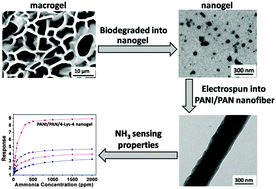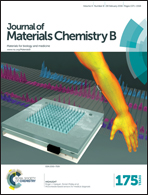A rapid ammonia sensor based on lysine nanogel-sensitized PANI/PAN nanofibers
Abstract
In this paper, L-lysine-based materials which are rich in amino groups were synthesized through a chemical reaction. The polyaniline/polyacrylonitrile (PANI/PAN) thin film and PANI/PAN nanocomposite (NC) thin films doped with L-lysine based materials were obtained by electrospinning and in situ polymerization of aniline. The gas sensing properties of the PANI/PAN thin film and PANI/PAN NC thin films doped with L-lysine based materials towards NH3, ethanol, acetone, chloroform and DMF were examined at room temperature. The experimental results reveal that the PANI/PAN/L-lysine based nanogel (4-Lys-4 nanogel) NC thin film exhibited a highly selective response toward NH3 at room temperature with improved response kinetics. The PANI/PAN/4-Lys-4 nanogel NC thin film showed the response of 5.5 with response and recovery times of 22 s and 15 s, respectively, toward 100 ppm NH3, and the detection limit of 2.2 ppm. This response and recovery are quite fast compared with the reported studies based on PANI doped with other materials. The enhanced response could be attributed to the large surface area, the core–shell structure of the nanofibers and improved charge transfer as a result of a certain amount of amino groups doping PANI. Our results clearly indicate that the PANI/PAN/4-Lys-4 nanogel NC thin film could effectively be used for the practical room temperature NH3 sensing application with quite fast response and recovery properties. At the same time, a new application of 4-Lys-4 nanogel on sensors is supplied.


 Please wait while we load your content...
Please wait while we load your content...